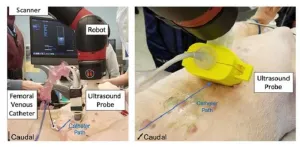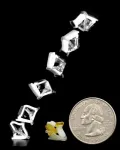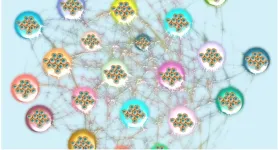(Press-News.org) Cardiovascular diseases rank among the top causes of death across the world, and cardiac interventions are similarly very common. For example, cardiac catheter ablation procedures, which are used to treat arrythmias, number in several tens of thousands per year in the US alone. In these procedures, surgeons insert a thin, flexible tube called a catheter into the femoral vein in the leg and navigate their way up to the heart, where the problematic tissue is destroyed using cold or focused radiation.
Even though cardiac catheter-based procedures are considered minimally invasive, the position of the catheter tip must be carefully monitored and controlled to prevent damage to the heart. In most cases, surgeons rely on fluoroscopy to localize and guide the catheter tip. However, this approach exposes both the patient and the medical staff to ionizing radiation, which can lead to problems such as increased risk of cancer or birth defects.
An alternative method to guide cardiac catheters involves photoacoustic imaging. In this approach, short laser pulses are delivered using an optical fiber attached to the catheter while a special signal transducer picks up the ensuing ultrasound waves generated within the heart. Photoacoustic images generated this way can be used to guide robotic arms manipulating the cardiac catheter to enhance precision and minimize risks. However, the algorithms used to automatically detect photoacoustic sources in these images, which are located close to the catheter tip, are susceptible to errors such as reflection artifacts.
A research team led by Muyinatu A. Lediju Bell, the John C. Malone Associate Professor in the Whiting School of Engineering at Johns Hopkins University, USA, has been working toward a solution to this issue. As reported in a new study published in the Journal of Biomedical Optics, they have developed a new approach for cardiac catheter localization through photoacoustic imaging by leveraging machine learning.
The researchers proposed using a deep convolutional neural network (CNN) to pinpoint the position of cardiac catheter tips in photoacoustic images. However, deep neural networks need to be trained on very large datasets to perform correctly, which would require hours of manual image acquisition and annotation. To circumvent this problem, the team turned to simulated data. “We trained the network with simulated channel data frames which we formatted to accommodate the field of view of the photoacoustic transducer, including multiple noise levels, signal amplitudes, and sound speeds, to ensure robustness against channel noise, target amplitude, and sound speed differences,” said Bell. To make the CNN more robust, the training dataset also included simulated images with artifacts.
The researchers introduced an additional processing step called “histogram matching” to further enhance the performance of the model. Herein, they automatically modified acquired images so that they looked similar to the simulated images used to train the CNN.
Through ex vivo and in vivo experiments on excised swine hearts and live swine, respectively, the team demonstrated the impressive performance of their deep learning-based approach. The positional errors for the catheter tip were remarkably small; most of them were even smaller than the resolution of the photoacoustic signal transducer. The network achieved Euclidean errors of 1.02 ± 0.84 mm for target depths of 20–100 mm. Furthermore, it exhibited great performance metrics, with precision, recall, and F1 scores as high as 100%. “Our results demonstrate the potential of the proposed method to identify photoacoustic sources in future interventional cardiology and cardiac electrophysiology applications, with the broader potential to replace fluoroscopy during these procedures,” said Bell, satisfied with the outcomes.
Overall, this study can pave the way for safer cardiac interventions that require catheters, helping doctors and patients alike in the fight against heart diseases.
For details, see the original Gold Open Access article by Gubbi et al., “Deep learning in vivo catheter tip locations for photoacoustic-guided cardiac interventions,” J. Biomed. Opt. 29(S1), S11505 (2023), doi 10.1117/1.JBO.29.S1.S11505.
END
Using deep learning to process raw photoacoustic channel data and guide cardiac interventions
The model automatically pinpoints the location of cardiac catheters in photoacoustic images, paving the way for safer cardiac procedures
2023-11-13
ELSE PRESS RELEASES FROM THIS DATE:
The Long Jump: Athletic, insect-scale long jumping robots reach where others can't.
2023-11-13
A team of engineers from the University of Illinois has published the first known study documenting the long-jumping motion of 3D-printed insect-scale robots.
The new study, published in the journal Smart Materials and Structures, follows a previous publication that documented the same lab’s investigation of vertical jumping in insect-scale robots. The study is led by Professor Sameh Tawfick, an associate professor and Ralph A. Andersen Faculty Scholar in the Department of Mechanical Science and Engineering. His lab, the Kinetic Materials Research Group, studies the ...
UMD engineers’ ‘cooling glass’ blasts building heat into space
2023-11-13
University of Maryland researchers aiming to combat rising global temperatures have developed a new “cooling glass” that can turn down the heat indoors without electricity by drawing on the cold depths of space.
The new technology, a microporous glass coating described in a paper published in the journal Science, can lower the temperature of the material beneath it by 3.5 degrees Celsius at noon, and has the potential to reduce a mid-rise apartment building’s yearly carbon emissions by 10%, according to the research team led by Distinguished University Professor Liangbing Hu in the Department of Materials ...
University of Oklahoma engineer elected as fellow member of Optica
2023-11-13
Optica, an international association in optics and photonics, recently announced the election of University of Oklahoma engineering professor Javier Jo, Ph.D., as a Fellow member.
Jo, a faculty member in the School of Electrical and Computer Engineering, was honored for his contributions to integrating optical imaging and artificial intelligence for biomedical applications. His research focuses on developing optical sensing and imaging technologies to understand pathophysiological mechanisms in human diseases and improve their clinical management.
“Dr. Jo’s ...
University of Toronto Engineering study finds bigger datasets might not always be better for AI models
2023-11-13
From ChatGPT to DALL-E, deep learning artificial intelligence (AI) algorithms are being applied to an ever-growing range of fields. A new study from University of Toronto Engineering researchers, published in Nature Communications, suggests that one of the fundamental assumptions of deep learning models — that they require enormous amounts of training data — may not be as solid as once thought.
Professor Jason Hattrick-Simpers and his team are focused on the design of next-generation materials, from catalysts that convert captured carbon into fuels to non-stick surfaces that keep airplane wings ice-free.
One ...
Acupuncture may offer limited relief to patients with chronic hives
2023-11-13
Annals of Internal Medicine Tip Sheet
@Annalsofim
Below please find summaries of new articles that will be published in the next issue of Annals of Internal Medicine. The summaries are not intended to substitute for the full articles as a source of information. This information is under strict embargo and by taking it into possession, media representatives are committing to the terms of the embargo not only on their own behalf, but also on behalf of the organization they represent.
----------------------------
1. Acupuncture may offer limited relief to patients with chronic hives
Abstract: https://www.acpjournals.org/doi/10.7326/M23-1043
Editorial: ...
Virologic rebound observed in 20% of patients treated with nirmatrelvir-ritonavir
2023-11-13
Embargoed for release until 5:00 p.m. ET on Monday 13 November 2023
Annals of Internal Medicine Tip Sheet
@Annalsofim
Below please find summaries of new articles that will be published in the next issue of Annals of Internal Medicine. The summaries are not intended to substitute for the full articles as a source of information. This information is under strict embargo and by taking it into possession, media representatives are committing to the terms of the embargo not only on their own behalf, but also on behalf ...
One in five patients experience rebound COVID after taking Paxlovid, new study finds
2023-11-13
A new study by investigators from Mass General Brigham found that one in five individuals taking Nirmatrelvir-ritonavir therapy, commonly known as Paxlovid, to treat severe symptoms of COVID-19, experienced a positive test result and shedding of live and potentially contagious virus following an initial recovery and negative test—a phenomenon known as virologic rebound. By contrast, people not taking Paxlovid only experienced rebound about 2 percent of the time. Results are published in Annals of Internal Medicine.
“We conducted this study to address lingering questions about Paxlovid and virologic rebound in COVID-19 treatment,” said corresponding ...
Scientists discover key to a potential natural cancer treatment’s potency
2023-11-13
JUPITER, Fla. — Slumbering among thousands of bacterial strains in a collection of natural specimens at The Herbert Wertheim UF Scripps Institute for Biomedical Innovation & Technology, several fragile vials held something unexpected, and possibly very useful.
Writing in the journal Nature Chemical Biology, a team led by chemist Ben Shen, Ph.D., described discovery of two new enzymes, ones with uniquely useful properties that could help in the fight against human diseases including cancer. The discovery, published ...
Mount Sinai researchers find more than 4,700 gene clusters crucial for prognosis in 32 cancer types
2023-11-13
New York, NY (November 13, 2023)—Researchers at the Mount Sinai Center for Transformative Disease Modeling have released a groundbreaking study identifying 4,749 key gene clusters, termed “prognostic modules,” that significantly influence the progression of 32 different types of cancer. The study, published in Genome Research, serves as a comprehensive resource and lays the foundation for the development of next-generation cancer treatments and diagnostic markers.
Despite significant progress in cancer research, understanding the disease's genetic intricacies ...
Ammonia fuel offers great benefits but demands careful action
2023-11-13
Ammonia, a main component of many fertilizers, could play a key role in a carbon-free fuel system as a convenient way to transport and store clean hydrogen. The chemical, made of hydrogen and nitrogen (NH3), can also itself be burned as a zero-carbon fuel. However, new research led by Princeton University illustrates that even though it may not be a source of carbon pollution, ammonia’s widespread use in the energy sector could pose a grave risk to the nitrogen cycle and climate without proper engineering precautions.
Publishing their findings in PNAS, the interdisciplinary team of 12 researchers found that a well-engineered ammonia economy could help the world achieve ...
LAST 30 PRESS RELEASES:
Bis-pseudoindoxyls: a new class of single benzene-based fluorophores for bioimaging applications
Blocking a cancer-related pathway helps reduce spine deformities due to genetic disorder, finds new study
New study explores therapeutic potential of CRISPRCas3 genome-editing system
Korea University researchers revive an abandoned depression drug target using structurally novel NK1 receptor inhibitors
Jeonbuk National University researchers highlight advancements in chemical looping fluidized bed reactors
Tyrannosaurus rex grew up slowly: New study reveals the “king of dinosaurs” kept growing until age 40
Commercial water dispenser machines may contain more contamination than tap water
Death and doctors: New WSU study looks at medical student education on end-of-life care
The best hydrogen for heavy-duty transport is locally produced and green
Pregnancy-related high blood pressure varied among Asian, Pacific Islander subgroups
Measuring movement creates new way to map indoor air pollution
Europe’s crop droughts to get worse even as rain increases
New study identifies signature in blood to better predict type 2 diabetes risk
Research spotlight: developing “smart” nanoparticles to deliver targeted gene therapy in osteoarthritis
A CRISPR fingerprint of pathogenic C. auris fungi
Time warp: How marketers express time can affect what consumers buy
CBD treatment reverses key effects of fetal alcohol spectrum disorder in a mouse model
Blood sugar spikes linked to higher risk of Alzheimer's disease
Staying single for longer affects young people’s well-being
New method allows scientists to 3D-print structures within cells
Screening tool helps identify brain-related comorbidities in individuals with Duchenne muscular dystrophy
How do the active ingredients of monkfruit affect health?
News language and social networks: how do they affect the spread of immigration attitudes?
Researchers discover trigger of tendon disease
Your pet's flea treatment could be destroying the planet
Diabetes risk not associated with timing or type of menopause
Bulk inorganic crystals grown from water emit “handed” light
A new AI-based attack framework advances multi-agent reinforcement learning by amplifying vulnerability and bypassing defenses
While exploring the cosmos, astronauts also fuel explorations of the biology of aging and cellular resilience
Design and synthesis of Zr-IR825 nanoparticles for photothermal therapy of tumor cells
[Press-News.org] Using deep learning to process raw photoacoustic channel data and guide cardiac interventionsThe model automatically pinpoints the location of cardiac catheters in photoacoustic images, paving the way for safer cardiac procedures




